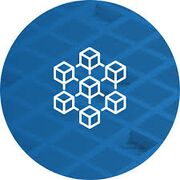Différences entre versions de « Blockchain Technology »
| (18 versions intermédiaires par 2 utilisateurs non affichées) | |||
| Ligne 11 : | Ligne 11 : | ||
<!-- ****************** Commercez les modifications ************************--> | <!-- ****************** Commercez les modifications ************************--> | ||
| − | [[{{FULLPAGENAME}}]] (Français) | + | [[{{FULLPAGENAME}}]] (Anglais) |
| − | / [[ | + | / [[Technologie de la chaîne de blocs]] (Français) |
| − | / [[ | + | / [[تقنية Blockchain]] (Arabe) |
| + | |||
| + | / [[Tecnología de cadena de bloques]] (Espagnol) | ||
| + | / [[Tecnologia Blockchain]] (Italian) | ||
| + | / [[Blockchain-Technologie]] (German) | ||
| + | |||
| + | / [[ブロックチェーンテクノロジー]] (Japonnais) | ||
| + | / [[区块链技术]] (Chinois) | ||
}}<!-- ************** Fin Fiche Didactique Traduction ********************* --> | }}<!-- ************** Fin Fiche Didactique Traduction ********************* --> | ||
| Ligne 49 : | Ligne 56 : | ||
<!-- *************** Commercez les modifications *******************--> | <!-- *************** Commercez les modifications *******************--> | ||
| − | * | + | * Blockchain |
| − | + | ||
| − | + | ||
| − | + | • Blockchains are distributed digital ledgers of cryptographically signed transactions that are grouped into “blocks” | |
| − | + | ||
| − | + | • Each block is “cryptographically” linked to the previous one after validation and undergoing a “consensus” decision | |
| − | + | ||
| − | + | • As new blocks are added, older blocks become more difficult to modify | |
| − | + | ||
| − | + | • New blocks are replicated across all copies of the ledger within the network, and any conflicts are resolved automatically using established rules | |
| − | + | ||
| + | |||
| Ligne 67 : | Ligne 75 : | ||
|Typologie= <!------------------------------------ Ne pas Modifier --> | |Typologie= <!------------------------------------ Ne pas Modifier --> | ||
<!-- ****************** Commercez les modifications ****************--> | <!-- ****************** Commercez les modifications ****************--> | ||
| + | |||
| + | * First Blockchain | ||
| + | |||
| + | • Bitcoin is the world’s premier blockchain | ||
| + | |||
| + | • Launched in 2009 by an anonymous person (or a group of persons) known by the name of Satoshi Nakamoto | ||
| + | |||
| + | • Suspiciously around the time of the Subprime crisis | ||
| + | |||
| + | • First successful peer-to-peer electronic cash system | ||
| + | |||
| + | • Bitcoin illustrates how we use blockchain to maintain a history of valid transactions that are tamper-resistant, without any effort from central authority | ||
| + | |||
| + | |||
*Centralized Systems | *Centralized Systems | ||
| − | + | ||
| − | + | • Homogeneous | |
| − | + | ||
| − | + | •Easier to design, operate, and maintain | |
| − | + | ||
| + | • Single point of control & authority | ||
| + | |||
| + | • Multiple users share same set of resources | ||
| + | |||
| + | • Single point of failure (- Honest, - Malicious) | ||
| + | |||
| + | |||
* Distributed Systems | * Distributed Systems | ||
| − | + | ||
| − | + | • A group of independent systems (nodes) working together for a purpose | |
| − | + | ||
| − | + | • Connected & communicate to each other via a network | |
| + | |||
| + | • Each operates concurrently | ||
| + | |||
| + | • Can continue correct operations even if some nodes fail | ||
}}<!-- ******** Fin Fiche Didactique Définition ******************* --> | }}<!-- ******** Fin Fiche Didactique Définition ******************* --> | ||
== {{Widget:Definition-graphique-Fiche}} == | == {{Widget:Definition-graphique-Fiche}} == | ||
| − | + | {{@}} [https://cmapscloud.ihmc.us/viewer/cmap/1Y37YT7YG-1RMVNLT-9KHFFT Carte conceptuelle sur la Blockchain] | |
<!-- ************************* Début ****************************** --> | <!-- ************************* Début ****************************** --> | ||
{{Fiche Didactique Media <!-------------------------------------------> | {{Fiche Didactique Media <!-------------------------------------------> | ||
| Ligne 146 : | Ligne 179 : | ||
• Performance | • Performance | ||
| + | |||
• Scalability | • Scalability | ||
| + | |||
• Redundancy (for fault-tolerance) | • Redundancy (for fault-tolerance) | ||
| + | |||
• How to ensure consistency among nodes of a distributed system? | • How to ensure consistency among nodes of a distributed system? | ||
| + | |||
• Even if some aren’t reliable nor honest? | • Even if some aren’t reliable nor honest? | ||
| + | |||
• Trust without trust? | • Trust without trust? | ||
| + | |||
• Requires a way to reach “consensus” | • Requires a way to reach “consensus” | ||
| + | |||
| + | |||
*Example: Database Systems | *Example: Database Systems | ||
| + | |||
• For a centralized database system, one central entity handles all requests and data processing | • For a centralized database system, one central entity handles all requests and data processing | ||
| + | |||
• Data updates simple and quick | • Data updates simple and quick | ||
| + | |||
• Cheaper to manage and maintain | • Cheaper to manage and maintain | ||
| + | |||
• Performance bottleneck under high concurrent requests | • Performance bottleneck under high concurrent requests | ||
| + | |||
• Single point of failure | • Single point of failure | ||
| + | |||
| + | |||
| + | * Distributed Database System | ||
| + | |||
| + | • A group of databases cooperating together to provide single data view to users | ||
| + | |||
| + | • Fault-tolerant | ||
| + | |||
| + | • Handle more concurrent load | ||
| + | |||
| + | • Requires “trust” among nodes (• Not a problem if owned by a single enterprise, • For nodes not fully trusting each other, a | ||
| + | “consensus” protocol is required to keep a consistent view of data) | ||
| + | |||
| + | |||
| + | * Distributed Ledger Technology (DLT) | ||
| + | |||
| + | • A type of distributed database system | ||
| + | |||
| + | • Immutable, append-only database of transactions (for example, exchanges of | ||
| + | assets or data) | ||
| + | |||
| + | • Ledgers are replicated, synchronized and shared across all nodes in the | ||
| + | distributed, peer-to-peer network | ||
| + | |||
| + | • Nodes reach consensus on transaction updates to its own copy of ledger, thus | ||
| + | maintaining consistent ledger state | ||
| + | |||
| + | • Via consensus protocol, this is achievable without central authority or trusted 3rd | ||
| + | party mediator | ||
| + | |||
| + | |||
| + | |||
| + | |||
}}<!--************** Fin Fiche Didactique Explicitations ******************* --> | }}<!--************** Fin Fiche Didactique Explicitations ******************* --> | ||
| Ligne 170 : | Ligne 249 : | ||
<!-- ****************** Commercez les modifications *************************--> | <!-- ****************** Commercez les modifications *************************--> | ||
| − | * Confusion entre [[ | + | * Confusion entre [[blockchain - bitcoin]] |
| − | * Confusion entre [[ | + | * Confusion entre [[public key - private key]] |
| − | * Erreur fréquente: | + | * Confusion entre [[Cryptographic hash - cryptography]] |
| + | * Erreur fréquente: blockchain is a database | ||
}}<!-- ************** Fin Fiche Didactique Conceptions ********************* --> | }}<!-- ************** Fin Fiche Didactique Conceptions ********************* --> | ||
| Ligne 185 : | Ligne 265 : | ||
<!-- ************ Commercez les modifications *********************--> | <!-- ************ Commercez les modifications *********************--> | ||
| − | * [[ | + | * [[How to ensure consistency among nodes of a distributed system]]? |
| − | * [[ | + | * [[How to achieve consensus among blockchain network participants in order to maintain ledger correctness and authenticity]]? |
| − | * [[ | + | * [[Blockchain = Bitcoin]]? |
| + | * [[What is Ethereum]]? | ||
| + | * [[What is Cryptoeconomics]]? | ||
}}<!-- ******** Fin Fiche Didactique Questions ******************* --> | }}<!-- ******** Fin Fiche Didactique Questions ******************* --> | ||
| Ligne 203 : | Ligne 285 : | ||
<!-- ****************** Commercez les modifications ************************** --> | <!-- ****************** Commercez les modifications ************************** --> | ||
| − | * | + | * Overview of everything |
| − | :* . | + | :* Centralized and distributed systems |
| − | * | + | :* Bitcoin: a distributed ledger of payments in crypto-currency |
| − | :* | + | ::*Identity |
| + | ::*Transaction | ||
| + | ::*Distributed Ledger in Bitcoin Network | ||
| + | ::*Trustless Consensus | ||
| + | :* Blockchain 2.0 : Beyond cryptocurrencies | ||
| + | ::* Adapting blockchain technologies for the real world | ||
| + | ::* Enterprise blockchain platforms | ||
| + | ::* Selected applications | ||
| + | ::* Limitations | ||
| + | * Bitcoin Mechanics | ||
| + | :* BTC: Notable history | ||
| + | :* BTC: Identity | ||
| + | :* BTC: Distributed Ledger - Blockchain | ||
| + | :* BTC transactions | ||
| + | :* BTC wallets | ||
| + | :* Mining mechanism and incentives, mining pool strategies | ||
| + | :* Possible attacks on the Bitcoin network | ||
| + | :* Try sending/receiving (fake) BTC on the testnet | ||
}}<!-- ************************* Fin Idées-Enseignement ********************** --> | }}<!-- ************************* Fin Idées-Enseignement ********************** --> | ||
| − | |||
== {{Widget:Aides et astuces-Fiche}} == | == {{Widget:Aides et astuces-Fiche}} == | ||
Version actuelle datée du 3 juin 2022 à 11:49
 Traduction
Traduction
Blockchain Technology (Anglais) / Technologie de la chaîne de blocs (Français) / تقنية Blockchain (Arabe)
/ Tecnología de cadena de bloques (Espagnol) / Tecnologia Blockchain (Italian) / Blockchain-Technologie (German)
/ ブロックチェーンテクノロジー (Japonnais)
/ 区块链技术 (Chinois)
 Définition
Définition
Domaine, Discipline, Thématique
Définition écrite
- Blockchain
• Blockchains are distributed digital ledgers of cryptographically signed transactions that are grouped into “blocks”
• Each block is “cryptographically” linked to the previous one after validation and undergoing a “consensus” decision
• As new blocks are added, older blocks become more difficult to modify
• New blocks are replicated across all copies of the ledger within the network, and any conflicts are resolved automatically using established rules
• Bitcoin is the world’s premier blockchain • Launched in 2009 by an anonymous person (or a group of persons) known by the name of Satoshi Nakamoto • Suspiciously around the time of the Subprime crisis • First successful peer-to-peer electronic cash system • Bitcoin illustrates how we use blockchain to maintain a history of valid transactions that are tamper-resistant, without any effort from central authority
• Homogeneous •Easier to design, operate, and maintain • Single point of control & authority • Multiple users share same set of resources • Single point of failure (- Honest, - Malicious)
• A group of independent systems (nodes) working together for a purpose • Connected & communicate to each other via a network • Each operates concurrently • Can continue correct operations even if some nodes fail |
Définition graphique
![]() Carte conceptuelle sur la Blockchain
Carte conceptuelle sur la Blockchain
 Concepts ou notions associés
Concepts ou notions associés
 Exemples, applications, utilisations
Exemples, applications, utilisations
• Performance • Scalability • Redundancy (for fault-tolerance) • How to ensure consistency among nodes of a distributed system? • Even if some aren’t reliable nor honest? • Trust without trust? • Requires a way to reach “consensus”
• For a centralized database system, one central entity handles all requests and data processing • Data updates simple and quick • Cheaper to manage and maintain • Performance bottleneck under high concurrent requests • Single point of failure
• A group of databases cooperating together to provide single data view to users • Fault-tolerant • Handle more concurrent load • Requires “trust” among nodes (• Not a problem if owned by a single enterprise, • For nodes not fully trusting each other, a “consensus” protocol is required to keep a consistent view of data)
• A type of distributed database system • Immutable, append-only database of transactions (for example, exchanges of assets or data) • Ledgers are replicated, synchronized and shared across all nodes in the distributed, peer-to-peer network • Nodes reach consensus on transaction updates to its own copy of ledger, thus maintaining consistent ledger state • Via consensus protocol, this is achievable without central authority or trusted 3rd party mediator |
 Erreurs ou confusions éventuelles
Erreurs ou confusions éventuelles
- Confusion entre blockchain - bitcoin
- Confusion entre public key - private key
- Confusion entre Cryptographic hash - cryptography
- Erreur fréquente: blockchain is a database
 Questions possibles
Questions possibles
 Liaisons enseignements et programmes
Liaisons enseignements et programmes
Idées ou Réflexions liées à son enseignement
- Overview of everything
- Centralized and distributed systems
- Bitcoin: a distributed ledger of payments in crypto-currency
- Identity
- Transaction
- Distributed Ledger in Bitcoin Network
- Trustless Consensus
- Blockchain 2.0 : Beyond cryptocurrencies
- Adapting blockchain technologies for the real world
- Enterprise blockchain platforms
- Selected applications
- Limitations
- Bitcoin Mechanics
- BTC: Notable history
- BTC: Identity
- BTC: Distributed Ledger - Blockchain
- BTC transactions
- BTC wallets
- Mining mechanism and incentives, mining pool strategies
- Possible attacks on the Bitcoin network
- Try sending/receiving (fake) BTC on the testnet
Aides et astuces
Education: Autres liens, sites ou portails
 Bibliographie
Bibliographie
Pour citer cette page: (Technology)
ABROUGUI, M & al, 2022. Blockchain Technology. In Didaquest [en ligne]. <http:www.didaquest.org/wiki/Blockchain_Technology>, consulté le 24, novembre, 2024
- ..................
- ..................
- ..................
- ..................
- Sponsors Education
- Blockchain Technology (Concepts)
- Centralized Systems (Concepts)
- Distributed Systems (Concepts)
- Distributed Ledger Technology (DLT) (Concepts)
- Distributed Ledger in Bitcoin Network (Concepts)
- Bitcoin (Concepts)
- Ethereum (Concepts)
- Non-Public Blockchains (Concepts)
- Big Consortia (Concepts)
- Blockchain Technology
- Bitcoin Mechanics
- Ethereum
- PoW vs PoS consensus
- Consensus models
- Enterprise Blockchain
- Blockchain Scaling
- Stablecoins
- Concepts
- Fiche conceptuelle didactique





